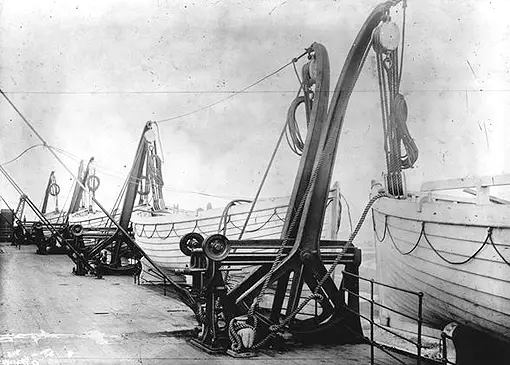11. A New Ship
Titanic's new officers had only days within which to familiarize themselves with miles of decks and companionways; only Murdoch was used to the new Olympic Class liners. Lightoller would write that it was 14 days before he could confidently make his way from place to place in Titanic's interior, and stated that younger officers joining later once spent most of a day trying unsuccessfully to locate a gangway door aft; there is no indication that he ever grasped the significance of their inability to do so. Nor did he comment unfavorably upon her truncated sea trials. Lightoller had come from the Oceanic, which he described as a mere steam yacht compared to the Titanic, and yet he assumed that a few turns and stops and a four hour steaming trial on April 2, 1912, were adequate preparation for taking her to sea, a belief obviously shared by company headquarters. Third Officer Pitman would describe Titanic's sea trials to Senator Smith as "just steaming around" (Page 260), a gem of understated inadequacy. The deck officers were evidently expected to discover her behavior without disrupting commercial schedules. On April 11, 1912, a passenger on deck in the early dawn hours would photograph Titanic's S shaped wake: the bridge, Henry Wilde on watch, was swinging the helm, testing her steering, a function which should have been well known before embarkation. On April 14th, when Murdoch ordered the ship to port and threw the engine room telegraph to full astern, he had no actual knowledge of what would happen next.
Lightoller reserved his scorn for White Star's assurances that company ships carried adequate safety equipment. The number of lifeboats was insufficient, their capacity was inadequate, and this was neither unknown nor unconsidered by White Star's officers: E. J. Smith, like Priam of Troy sensing a disaster he was powerless to prevent, was acutely sensitive to the lack of lifeboats. In 1907 he had stated bluntly to a worried passenger that should the Adriatic go to the bottom, many on board would go with her, and in 1911 on the Olympic had confided to a friend that the lack of lifeboats for half the thousands aboard was a nagging worry: it was, he said, on his mind constantly whenever not in port; the unfinished Titanic, Smith continued, would be no better provided.

Titanic's lifeboats
Why then, did Titanic's owners accept delivery of a virtually untested and inadequately provided vessel? Why did the Board of Trade surveyor sign her Passenger Certificate without demur? Why did her officers agree happily, indeed eagerly, to take her across the Atlantic in the winter's wake, with junior officers still groping about her maze like interior and with assorted details being corrected ad hoc by a committee of Harland & Wolff men still fiddling about when she struck the iceberg? The rush was precipitated by the deadline for sailing; but why the deadline? (Why did the Trojans not simply give Helen back?) If such questions had been put, the answer would no doubt have been, why not?
The financial exigencies of a corporate giant engaged in the absorbing task of making money was, of course, part of the hurry, but there was a deeper reason: nothing that was done was in any way opposed to what was then the standard procedure, and until the Titanic passed into legend and thus into law, it was felt that custom and tradition encompassed carefulness and prudence. According to Walter Lord, who was there, White Star did not muster passengers in lifeboat drills after the purported reforms of 1912. The company, apparently, was the world's slowest learner. Mr. Lord's delightful description of White Star's ships and their management compresses history into two words: "sloppy cathedrals."
Captain Smith, despite his fears, accepted command without hesitation; his only stated desire, should the thing he most dreaded happen, was that all aboard behave with decorum "Birkenhead courage", in emulation of one of the more ghastly sinkings of the 1850s. There is no indication that in 1912 he had changed his mind, or planned any action suitable for tragedy other than dignified resignation. E. J. Smith had grown old in the service of the White Star Line, and he was now about to retire from a lifetime of reciprocal command and obedience; it was too late to change the mental habits of nearly 60 years. So he worried, and acceded to the company's wish take Titanic to sea, exactly on time, no matter what.
Sailing time was fixed for noon, April 10, 1912. There was a particularly nasty coal strike in Britain, spreading misery and unemployment. White Star, however, was unimpressed by strikes, and no more proposed to let this one delay Titanic than they had permitted labor disputes to postpone the maiden voyages of Adriatic and Olympic. To obtain coal for Titanic company officials elected to raid the bunkers of liners idled by the shortages. The decision meant manhandling tons of coal from ship to ship, thereby increasing the chronic risk of the age of steam: a deadly, smoldering coal fire. The coal was duly transferred, and a fire started; it would burn and be fought until the morning of April 14, when Chief Engineer Bell advised Captain Smith that it was finally out. It was one more anxiety for the bridge.
In addition to the shortage of fuel and the dangers from fire, Captain Smith had also to contemplate the most unpredictable if not altogether the most fearful of hazards: the changeable weather in the North Atlantic. It had been a bad winter. In January, ice had stopped Hudson River shipping altogether, ships on the Mississippi and Ohio Rivers were wrecked or disabled by floes and ice jams, and the U.S. Atlantic fleet had been caught by a blizzard off Cape Hatteras, North Carolina every ship in the fleet reported damage. In February, there was ice as far south as Chesapeake Bay and gales and high seas were reported by liners limping into New York, where more ice in the East River hampered shipping. On February 16, the Adriatic arrived 24 hours late due to bad weather on the North Atlantic; so bad that all her lifeboats had been smashed to kindling. The Lusitania was 24 hours late on February 25th, delayed by storms and ice. On March 10th, the Mauritania, alleged to have the mightiest engines on the Western Ocean, was a day late docking due to foul weather, and three days later the Holland America Line's Rotterdam reported two crewmen killed and two injured because of heavy seas encountered en route. On March 17th, three ships sank in one night in a gale off the Atlantic Coast. And on April 12th, Cunard's Carmania, in mid Atlantic, advised New York by wireless that she had passed through extensive ice fields off the Grand Banks; the New York Times printed her warning on Page 1.
The Olympic left Southampton for New York on April 2, 1912, (the day of Titanic's sea trials), well prepared for delays en route; despite the coal strike, she carried an extra supply, stored in the third class dining room. Olympic's Captain Haddock may have anticipated severe storms, or may have contemplated the need to detour ever further south to skirt ice known to be present, or may simply have been over cautious. He was, in any event, prepared for a longer voyage than usual.
